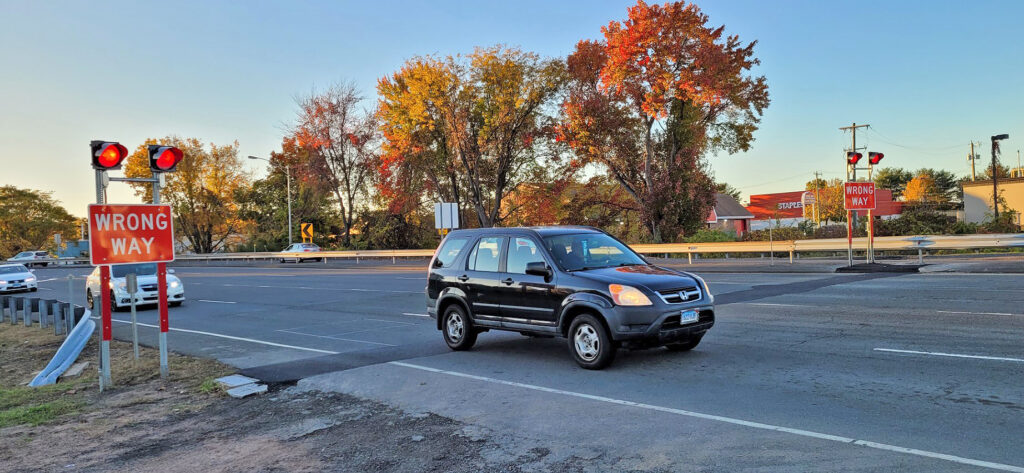By Olivia Drake, Written Communications Specialist
“You’re going the wrong way!”
Not if researchers at the University of Connecticut can help put a stop to it.
As part of the state’s strategy to bring attention to wrong-way driving detection and prevention, faculty from the School of Engineering are developing and testing a new driving alert system that could help prevent, or stop, drivers from going the wrong way on state roads. In 2022, wrong-way driving crashes in Connecticut tripled; a staggering 567 motor vehicle crashes involved wrong-way drivers, resulting in 23 fatalities and 35 major injuries.
“The state is seeing more and more of these wrong-way driving crashes,” said Eric Jackson, associate research professor of civil and environmental engineering (CEE) and director of the Connecticut Transportation Safety Research Center (CTRSC). “Studies have shown that wrong-way driving crashes are 100 times more likely to be fatal than other types of crashes and the School of Engineering is already working on a solution to help combat this growing problem and help keep Connecticut roads safer for our families and friends.”
On June 13, Connecticut Governor Ned Lamont signed Public Act 23-51 into law, which expands the use of wrong-way driving alert systems. The act requires the Connecticut Department of Transportation (CTDOT) to expand efforts to implement wrong-way driving countermeasures, and they’re looking to a team at UConn for guidance.
In 2020, Jackson, along with CEE Professor Jeongho Kim, alumna Sukirti Dhital ’21 PhD (ENG), and former graduate student Toby Poole developed a new, in-ground Wrong-Way Rumble Strip (WWRS) design. WWRS are designed to alert drivers when they are traveling in the wrong direction though dynamic vibration feedback. Their design is an extension of a study completed at Auburn University in 2020.
“[The researchers at Auburn University] had the rumble strip at the ground surface. We selected one of their proposed patterns and extended the study by changing the design of the rumble strip in terms of shape, length and depth,” Dhital explained.
By using a technology called finite element analysis, the team set out to design an optimum WWRS that produces maximum vibration at the driver’s seat while ensuring minimal damage to the tire.

The team used a dynamic simulation software called Adams Car to test multiple rumble strip designs of varying shapes (triangular, curved, and trapezoidal); lengths (9 and 12 inches; and depths (2 and 2.5 inches). In Adams Car, the team used a default sedan to traverse the strips at 10, 20, 20, and 45 mph in both right-way and wrong-way directions.
“A predictive model drastically reduces the cost and time required to prototype WWRS,” Kim explained. “The software provides the most effective design selections of the rumble strip before any field tests are done.”
The research team additionally performed a statistical “t-test” to compare differences in vertical and longitudinal acceleration, and an Analysis of Variance (ANOVA) test to understand how variations in the cross-sectional geometry of the rumble strip effects the amplitude of vibrations at the driver’s seat.
Ultimately, the team concluded that a 12-inch-wide, 2-inch-deep, trapezoidal obstacle—located below the road’s surface—would make the most effective WWRS design.
“We were pleased with the overall outcome,” said Dhital, who presented the group’s findings to the Transportation Research Board in 2022. “The curved and trapezoidal profile provided similar results. However, we selected the trapezoidal shaped rumble as that would be easier to construct in the field. We also changed the length and depth of each shape. The increase in length and depth did increase the overall vertical acceleration experienced by the driver in both right and wrong direction. But we would require field tests to give us more confidence in our findings.”
The WWRS team and CTSRC now have the go-ahead to develop a proposal and then begin field tests. The legislation set aside $20M for wrong way driving projects, UConn will work with CTDOT to allocate some of that funding towards developing construction methods and evaluating materials for prototypes. After creating prototypes, researchers will deploy the rumble strips in a controlled test environment on UConn’s Depot Campus, where the researchers can analyze and validate the simulation results.
“If successful, the results of this project could result in a new, novel, low technology-based application to alert drivers they are traveling in the wrong direction,” Jackson said. “There may also be benefits for drivers traveling in the correct direction. They will be alerted when approaching an intersection at the end of the off ramp.”

After UConn completes its testing, researchers will share their findings with CTDOT. CTDOT must submit a report to the Legislature by Jan. 1, 2025, which will highlight the test results and make recommendations for installing WWRS and other wrong-way driving alert systems statewide.
The research is part of the state’s larger strategy of bringing public awareness to the dangers of wrong-way driving as part and reversing the catastrophic recent increase in wrong-way crashes and deaths.
“It is shocking how quickly the number of wrong-way driving incidents has accelerated over these last couple of years, and we need to do more to prevent them,” Governor Lamont said in a recent press release. “Reversing this trend requires a comprehensive approach that not only involves infrastructure upgrades using advanced technology, but also requires a heightened awareness by drivers every single time they are entering a highway. This is an issue that we cannot take lightly, and we must continue researching new and emerging methods of preventing wrong-way driving incidents.”



